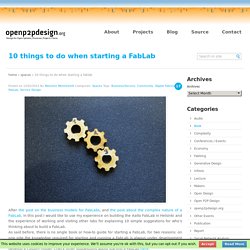

Business_model_canvas_poster.pdf. Fab Lab Business Models. Business Models for Fab Labs. Few months ago, Platoniq commissioned me a report about business models for Open Hardware, DIY Craft and Fab Labs, for their crowdfunding project Goteo. It is now available here in English, under a Creative Commons Attribution-Noncommercial-Share Alike 3.0 Unported License; it will be soon available in Spanish from Platoniq’s YouCoop website. Just note that the two versions may slightly differ (it happens when you work on two different versions of the same document); the idea is to transform it in a collaborative book in the future, here on openp2pdesign.org. After the part about Open Hardware, here’s now the second part, about business models for Fab Labs.
Fab Labs and other places for designing and making collaboratively As we have seen in the previous post, Open Hardware and similar Open projects can grow as communities inside specific places like hackerspaces. View Fab Labs on Earth in a larger map Funding a Fab Lab: how much does it cost? Running a Fab Lab: Business Models. Massimo Menichinelli on the Ten Characteristics of FabLabs. Excerpted from Massimo Menichinelli: 01.

A space about bits and atoms “Though it may be also a space for developing prototypes or building final working products, the main goal for a FabLab is to be a space for experimenting at the intersection of bits and atoms, information and matter. It is not by accident that the concept has been developed at MIT at the Center for Bits and Atoms, not at the High-Low Tech research group. That’s why there is a huge adoption of tools and components for working with electronics, for example. 02.
Being a FabLab means being part of a global network of local nodes, and this aspect is very important, much more developed than in hackerspaces, makerspaces and TechShops. This is also why nodes should share the same set of tools and processes (though local experimentations are welcome): in order to enable any project to be replicated in any node of the network. 03. 04. 05. 06. 07. 08. If you are looking for a franchising, probably TechShops are closer to that.
10 things to do when starting a FabLab. After the post on the business models for FabLabs, and the post about the complex nature of a FabLab, in this post I would like to use my experience on building the Aalto FabLab in Helsinki and the experience of working and visiting other labs for explaining 10 simple suggestions for who’s thinking about to build a FabLab.

As said before, there is no single book or how-to guide for starting a FabLab, for two reasons: on one side the knowledge required for starting and running a FabLab is always under development and evolution, on the other side the unique conditions of the local context require each time to develop a custom model. Check other suggestions about starting a FabLab here. 01.
Start from the local conditions Always start from understanding and defining the local conditions and how they will influence your project. 02. 03. 04. 05. Generally, developing a FabLab takes more than what you think… it always happens!